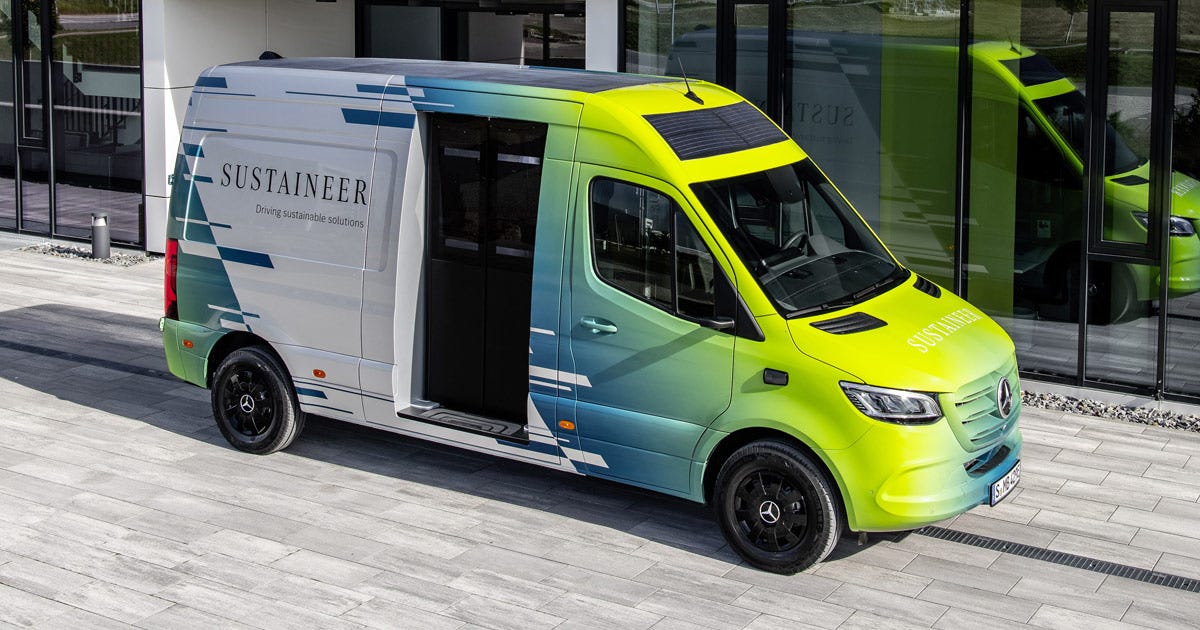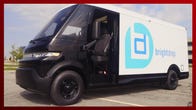The Sustaineer concept is a shock block with environmentally friendly features.
Mercedes-Benz
Wednesday, Mercedes-Benz unveiled its Sustaineer commercial van concept. Short for “sustainability pioneer,†this all-electric design study is based on the automaker’s eSprinter and packed with features designed to conserve resources, improve the health and safety of city dwellers, and even protect the climate.
What’s interesting about the Sustaineer is that none of these items are weird or overly complicated. Many of its green features could be implemented quickly and relatively cheaply, which Mercedes-Benz will likely do in its vans in the future. In markets where possible, the division aims to be fully electric by the end of this decade. By 2022, production is expected to be carbon neutral at all company-owned van factories around the world; they will only use renewable electricity. Finally, as part of its Ambition 2039 strategy, the Mercedes-Benz vans The group wants to be carbon neutral throughout the life cycle of its vehicles, from manufacturing to charging, service and everything in between. The concepts highlighted in the Sustaineer can help the automaker achieve these lofty goals.
One of the features of this pickup – and the most curious – is its particulate filtration system. The Sustaineer has two particulate filters, one mounted behind the grille and the other under the body. You might think these units are part of an emissions control system, but remember this pickup truck is fully electric. Instead of cleaning the exhaust gases, these filters are actually used to purify the air while driving and charging, trapping particles down to 10 microns. This can dramatically improve air quality in densely populated urban areas with high vehicle emissions, especially if there are large fleets of vehicles equipped with such filtration systems.
There is a lot of space – and renewable materials – inside this concept van.
Mercedes-Benz
But it’s not just internal combustion engines that emit particulate matter. According to Mercedes-Benz, they only make up about 12% of them. Tires, brakes, and the road surface itself all produce fine dust that affects air quality. To further reduce these emissions, the Sustaineer is fitted with low rolling resistance tires and ceramic coated cast iron brake discs. Fleet customers will also appreciate these components, as they are expected to last longer in service, reducing maintenance costs.
The Sustaineer also reduces another type of pollution: noise pollution. This minivan’s electric powertrain is quieter than a combustion engine, but that’s not all. Low rolling resistance tires are not only more efficient, they also produce less noise than other tires. Finally, the Sustaineer has what Mercedes-Benz calls a fast delivery door, which opens automatically. This improves operator efficiency, but it’s also much quieter than conventional sliding doors. For drivers with around 150 stops on their delivery routes, not having to manually open and close a door can save up to 25 minutes a day – a significant amount of time.
Reducing its carbon footprint, the roof of this commercial van concept is lined with nearly 52 square feet of solar panels. In an often gray and cloudy Germany, this can provide around 828 kWh of additional energy per year, which equates to around 1,500 miles of range per year. In sunnier places like Spain, these panels can produce 1,200 kWh of juice, enough to provide over 1,700 miles of off-grid range.
Two external particulate filters help purify the air while this vehicle is in motion.
Mercedes-Benz
In electric vehicles, air conditioning systems can swallow loads of electricity. Running a resistive heater in the dead of winter is a great way to quickly reduce your car’s battery capacity. To improve efficiency, the Sustaineer has an innovative heating system, which supplies heat directly to the driver. This minivan has a heated seat and steering wheel, but the seat belt is also heated, lined with fine metal filaments that produce 70 watts of power. All of this is designed to directly heat the driver, rather than the air inside the Sustaineer. For commercial delivery vans, which have large interiors and doors that always open and close, this could dramatically improve efficiency.
Direct heating of the body can also improve safety. This heated seat belt encourages the driver to remove their coat in winter to better feel the heat, reducing seat belt slack for better protection in a crash.
By further strengthening its green image, this van concept includes many environmentally friendly materials that are either recycled or of sustainable origin. The base panels are made of old tires and polypropylene; the partition between the cabin and the loading area is made of straw, a renewable, recyclable, biodegradable and formaldehyde-free agricultural by-product; all wooden components of the Sustaneer are made from wood harvested from responsibly managed forests; and finally, the steering wheel cover is in vegan leather.
In addition to its efficient all-electric air transmission and filtration system, the use of recycled materials and intelligent heating, the Mercedes-Benz Sustaineer also comes with intelligent software designed to facilitate fleet management, it is Equipped with digital mirrors inside and outside that provide a greater field of view and it can even monitor the roadway for potholes or other damage and report problems to the municipalities concerned. There are a lot of clever ideas in this concept, many of which will likely find their way into production vans in the not-so-distant future.
Mercedes-Benz Sustaineer: The Future of Commercial Delivery
See all photos


